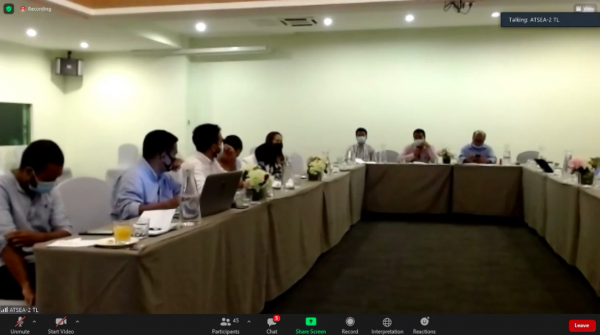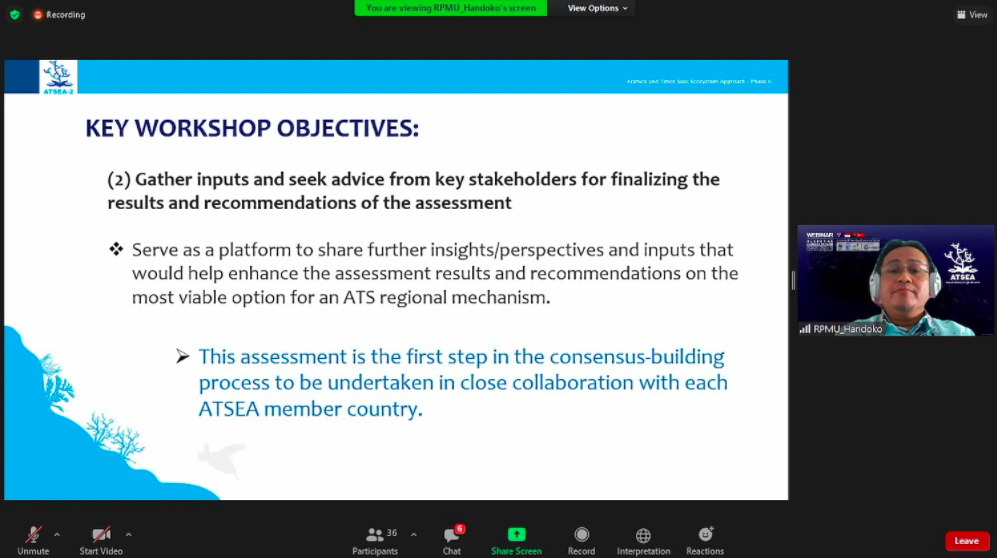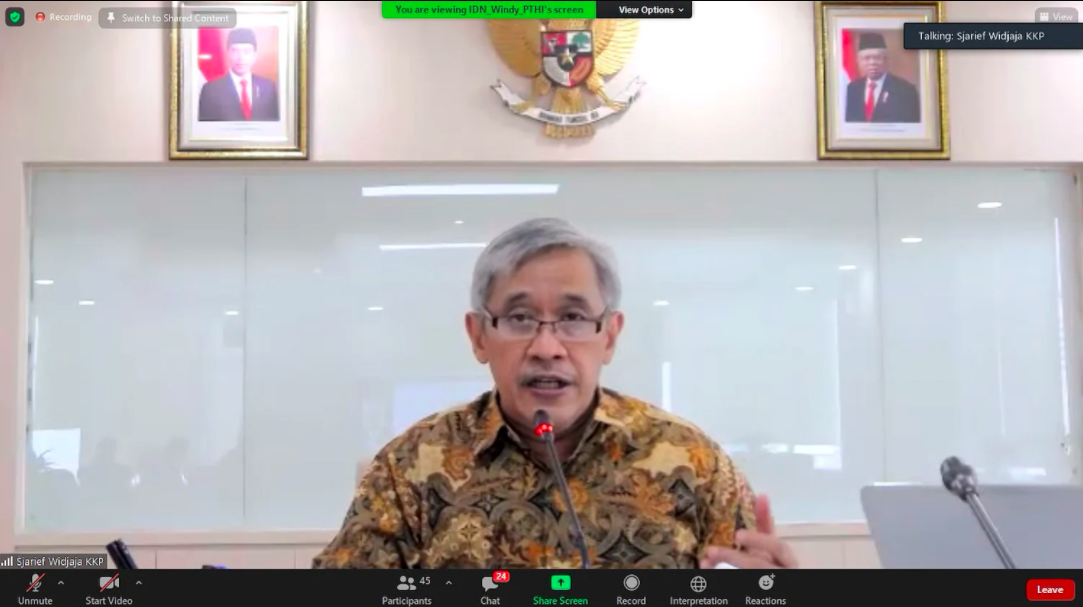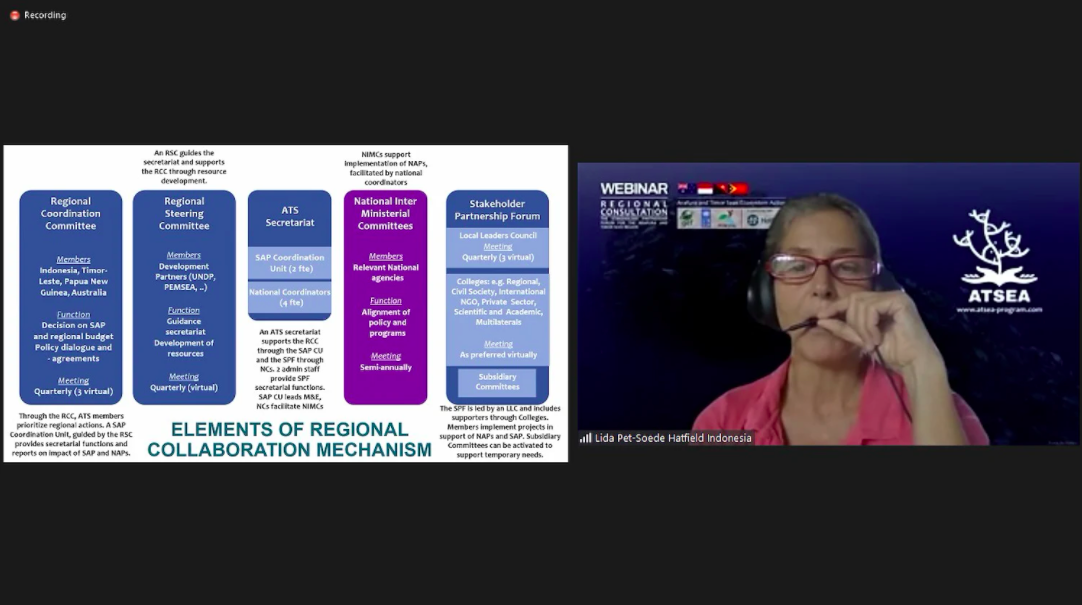RGM and SPF workshops: Bringing a shared vision for the ATS region into focus
Tuesday, 12 October 2021

This article was originally published on IW:Learn on June 6, 2021
GEF IW:LEARN World Oceans Day 2021 Special Issue
In 2014, the littoral countries of Australia, Indonesia and Timor-Leste jointly committed to strengthen governance of the Arafura and Timor Seas (ATS) region. Their aim was to achieve key environmental objectives and targets, in line with a shared vision for sustainable development in the region. In support of this, and with the participation of Papua New Guinea, the GEF/UNDP/PEMSEA ATSEA-2 Programme has engaged PT Hatfield Indonesia to undertake an assessment of viable options for Regional Governance Mechanism (RGM).
Solutions include a Strategic Action Programme (SAP) and National Action Programmes (NAPs) in the ATS region; the establishment of a Stakeholder Partnership Forum (SPF); and improved inclusion among the wider stakeholder base in the ATS region, including representatives of local people and women’s groups. Two regional consultations were convened in May 2021, to present the regional governance mechanism and seek inputs to refine and finalise the proposed arrangements.
Regional Consultation on the Mechanism for Collaborative Action in the ATS Region
Held virtually on 19 May 2021, the first regional consultation meeting was attended by members of the ATSEA-2 Regional Steering Committee and National Project Boards. Initial remarks were provided by Dr. Handoko Adi Susanto, ATSEA-2 Regional Project Manager, who outlined the meeting’s objectives and its expected outputs. The event was then officially opened by Dr. Sophie Kemkhadze, Deputy Resident Representative of UNDP-Indonesia and Principal Project Representative for the ATSEA-2 Programme.
Dr. Lida Pet-Soede (PT Hatfield Indonesia) shared key findings and recommendations for the regional mechanism, which was followed by structured feedback from five formal reviewers: Prof. Sjarief Widjaja from the Ministry of Marine Affairs and Fisheries of Indonesia; Acacio Guterres, Director General of the Ministry of Agriculture and Fisheries of Timor-Leste; Dr. Andrew Chek from the Department of Agriculture, Water and Environment of Australia; Dr. Tonny Wagey, Former Project Manager of the first phase of ATSEA; and Ms. Aimee Gonzales of PEMSEA.

The proposed regional mechanism includes:
- A Regional Coordinating Committee (RCC) that will serve as overall policy and decision-making body for the ATSEA-2 Programme, through which ATS members can prioritise regional actions;
- A SAP Coordination Unit, guided by a Regional Steering Committee (RSC), which will provide secretariate functions to the RCC and lead M&E for the SAP and NAPs; and
- A Stakeholders Partnership Forum (SPF), led by a Local Leaders Council (LLC) and supported by a small secretariat, made up of national coordinators and staff.
Reviewers recognised the importance of collaboration at the regional level, the implementation of priority actions at the national and sub-national levels, and the engagement of local governments and communities. Recommendations included simplifying the proposed structure, to ensure clarity in the decision-making process. They also underscored the need to build on political support and improve synergy between countries in the ATS region.
In the open discussion, representatives from Papua New Guinea and Timor-Leste affirmed the need for strategic partnerships, collective dialogue and additional research to support SAP implementation. Dr. Jose Padilla of the UNDP Bangkok Regional Hub called for follow-up country consultations on the proposed design for the regional mechanism, while Prof. Karen Edyvane of Charles Darwin University recommended further engagement with thematic working groups, in relation to transboundary issues in the region.




Regional Consultation on the Stakeholder Partnership Forum
On 21 May 2021, a follow-up virtual regional consultation workshop was held, focusing on the design and operating mechanisms of the SPF. The meeting was attended by representatives from national and local governments; academic and research institutions; international/national/local NGOs; civil society organizations; and community groups, including women’s groups, private/business sector and multi-lateral/donor organizations working in the ATS region. Moderated by Dr. Tonny Wagey, the meeting discussed the following:
- Implementing the SAP and NAPs at the national and sub-national levels
- The role of a Local Leaders’ Council in implementing the SAP and NAPs
- Capacity development, knowledge sharing and technical or financial assistance
- The role of the Secretariat in supporting the SPF and coordinating with the RCC
In this meeting, participants provided feedback through the online Mentimeter tool and through a moderated open discussion. They also shared their perspectives in breakout groups, focusing on the following:
- Stakeholder involvement and the role of the SPF in ensuring inclusive engagement
- Effective and efficient coordination among various members and the RCC
- Interventions related to the priority transboundary issues in the ATS region
- Limitations regarding resources, capacity, awareness and logistics at the local level
At the conclusion of the meeting, the ATSEA-2 Regional Project Management Unit (RPMU) shared the next steps for further refinement of the proposed design of the ATS regional governance mechanism, which will include conduct of country consultations prior to presentation to the 3rd Regional Steering Committee Meeting. The RPMU also encouraged participants to provide further recommendations, in order to foster shared objectives among the four countries in the ATS region.
About the ATSEA-2 Programme
ATSEA-2 is the second phase of the Arafura & Timor Seas Ecosystem Action (ATSEA) programme; a regional partnership involving the governments of Indonesia, Timor-Leste and Papua New Guinea, with the support of the Australian Government. Its objective is to collectively manage high marine and fisheries resources in the Arafura and Timor Seas (ATS) region. Since its inception in 2019, the programme has been working to promote sustainable development in the ATS region and improve the quality of life of its inhabitants through a combination of restoration, conservation and sustainable management of marine-coastal ecosystems. The ATS is an area of high productivity in the region and ATSEA-2 is committed to safeguarding the livelihoods and prosperity of coastal people, particularly in its transboundary areas, through the implementation of sustainable integrated concepts. ATSEA-2 is a Global Environment Facility (GEF)-funded programme, managed and executed under the United Nations Development Programme (UNDP). Partnerships in Environmental Management for the Seas of East Asia (PEMSEA) Resource Facility (PRF) is an implementing partner.
For more information on the ATSEA-2 programme, please contact the Regional Project Manager, Handoko Adi Susanto (hasusanto@pemsea.org), visit the project page on iwlearn.net or the project website.



